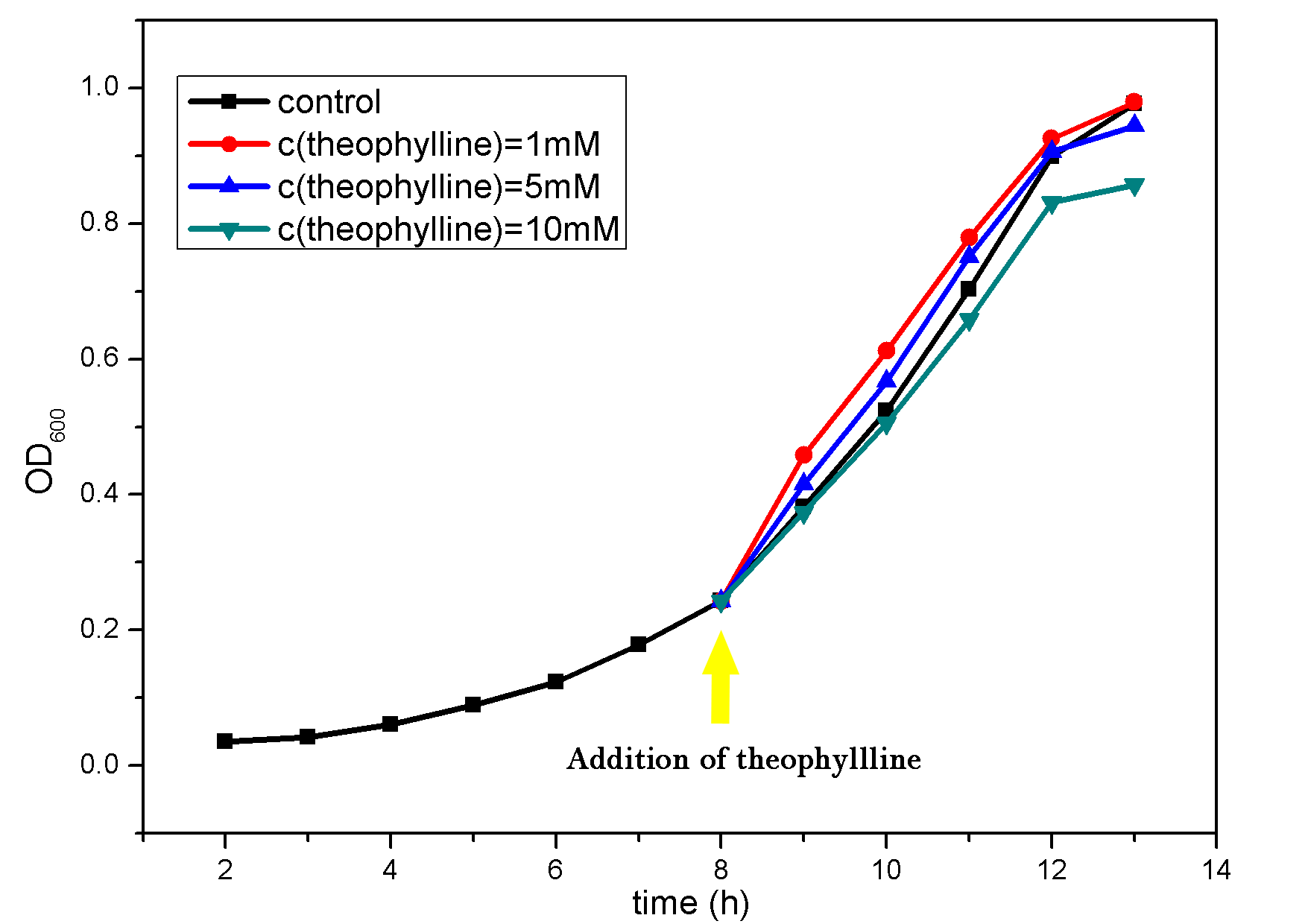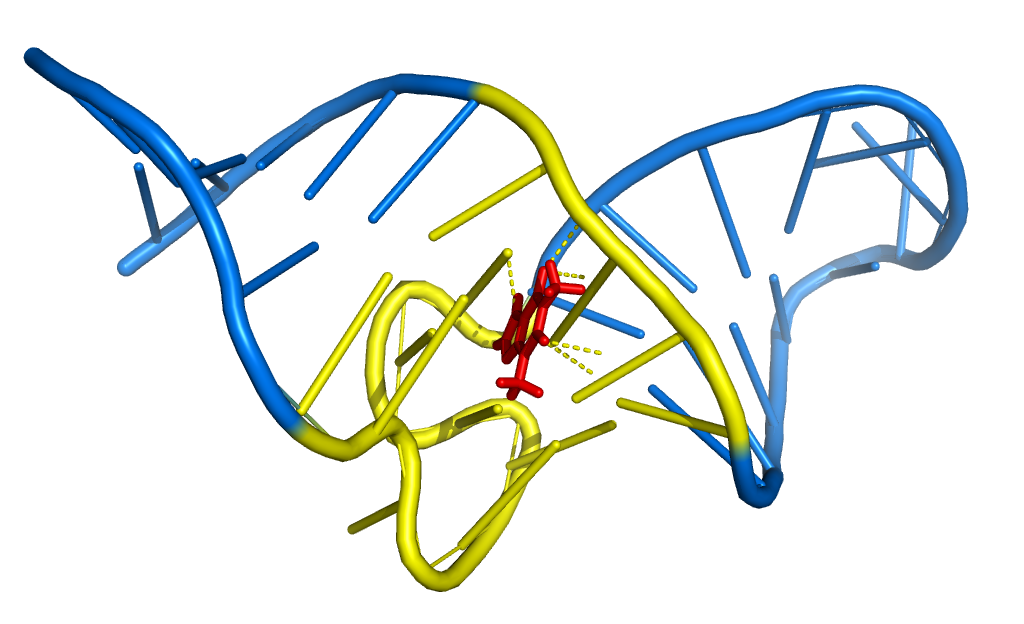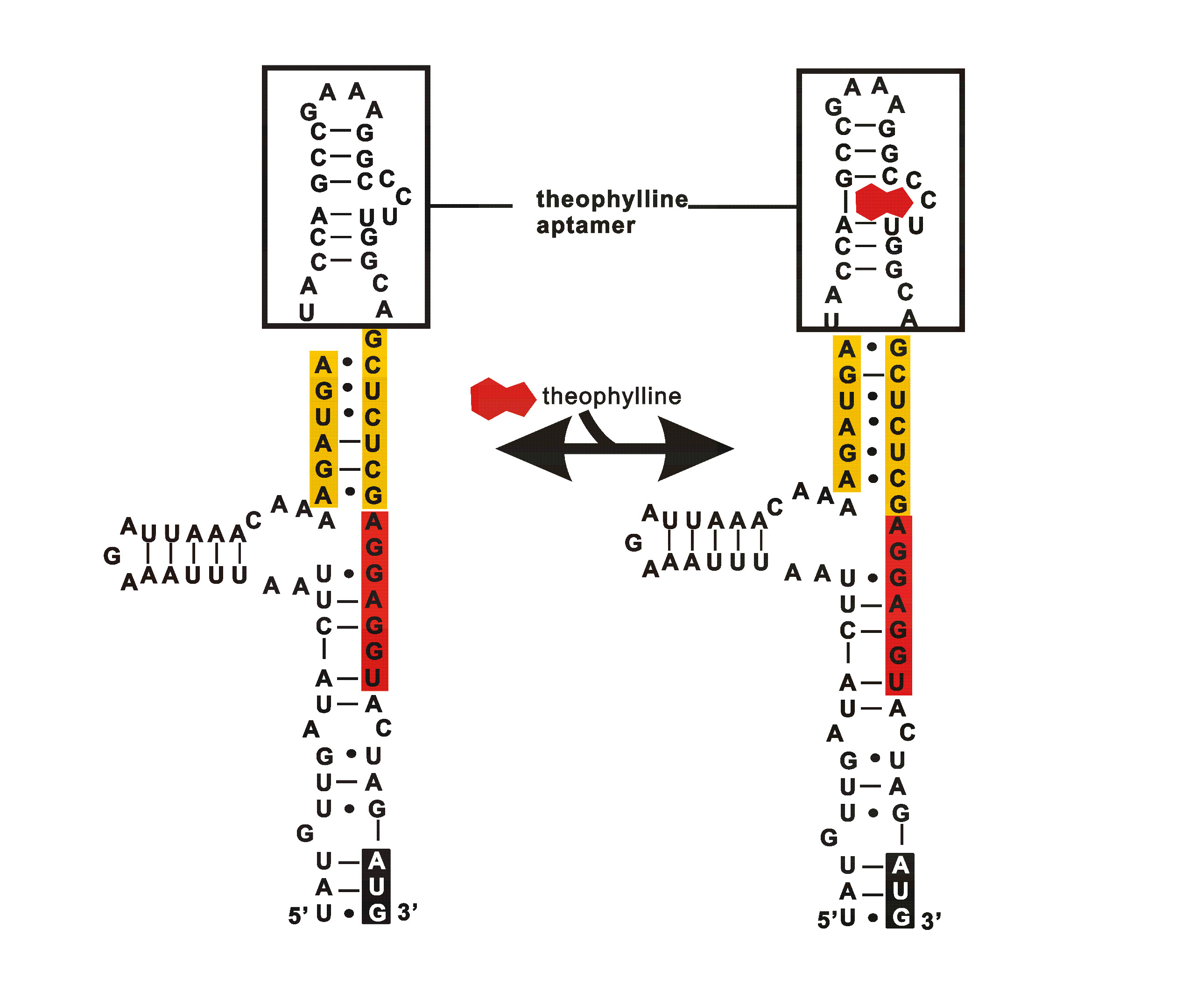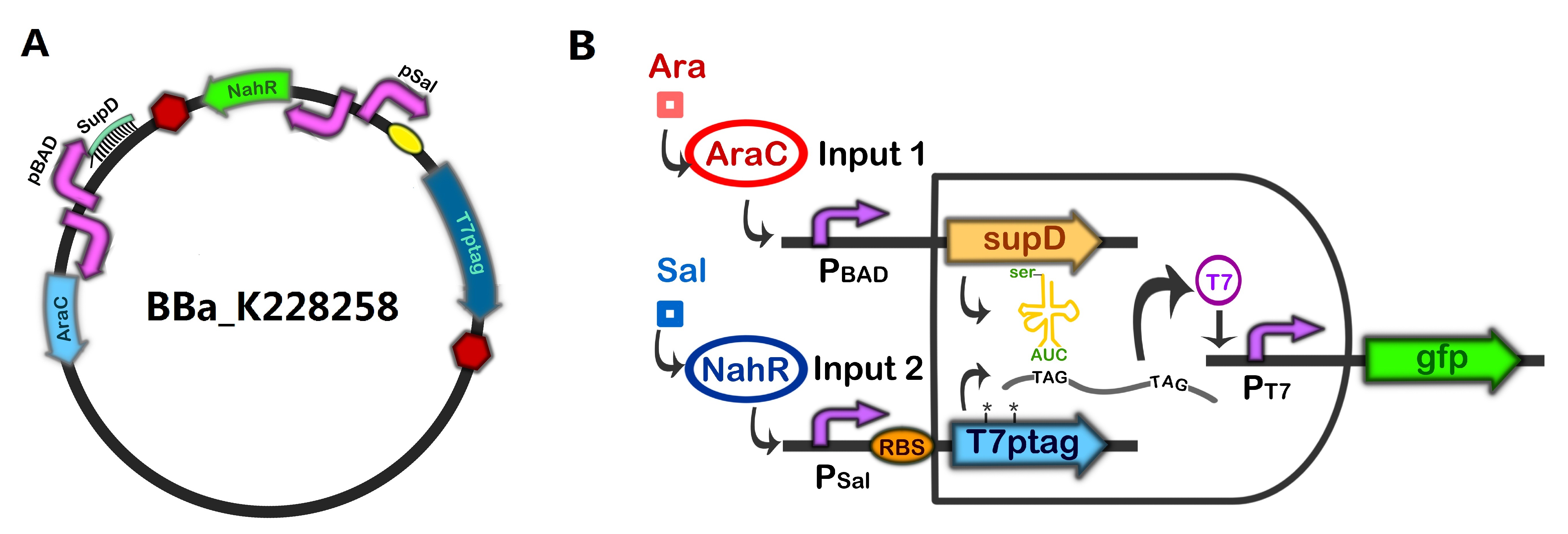Part:BBa_K598001
Theophylline Responsive Riboswitch 1G1 with Engineered RBS+GFP generator
This is a GFP generator regulated by theophylline responsive riboswitch. mRNA with a theophylline riboswitch in it responds to theophylline concerntration, producing different fluorescence strength of GFP. Regulated by different promoters, it would be used to demonstrate theophylline responsive curve, providing data for [http://2011.igem.org/Team:Peking_R/Project/RNAToolkit modeling].
Sequence and Features
- 10COMPATIBLE WITH RFC[10]
- 12COMPATIBLE WITH RFC[12]
- 21INCOMPATIBLE WITH RFC[21]Illegal XhoI site found at 71
- 23COMPATIBLE WITH RFC[23]
- 25COMPATIBLE WITH RFC[25]
- 1000INCOMPATIBLE WITH RFC[1000]Illegal BsaI.rc site found at 730
Background
Riboswitches are structured non-coding RNA domains performing as genetic control elements, regulating gene expression through ligand-RNA interactions without assistance of proteins. Several natural riboswitches have been reported, sensing small molecules including vitamin B1 and B12, FMN, SAM, lysine, guanine, adenine, TPP and theophylline [1]. Various mechanisms are utilized to regulate gene expression, ranging from transcription initiation to translation attenuation.
Theophylline responsive riboswitches have been widely studied in recent years. Theophylline is a small molecule which is passable through bacterial cytomembrane, but not an essential nutrient of bacteria. Although theophylline has moderate toxicity leading to growth inhibition in logarithmic phase with 15mM theophylline in LB medium, this theophylline responsive riboswitch shows an approving regulation curve under 10mM theophylline concentration with negligible growth inhibition in M9 liquid medium (Fig.1).
Experimental Data
Parental 1G1
We adopted the original theophylline responsive riboswitch, named Parental 1G1 (P1G1) in our project, designed by Beatrix Suess on Nucleic Acids Research, as a candidate of our [http://2011.igem.org/Team:Peking_R/Project/RNAToolkit RNA controller toolbox]. Stereo representation of the three-dimensional structure of theophylline aptamer is schematized in Fig.2.
Theophylline responsive riboswitch P1G1 integrates the theophylline aptamer with a helical communication module based on a ligand–dependent one-nucleotide slipping mechanism (Fig.3) [2]. This structural element lies at a position just interfering with translation in the non ligand-binding form. Addition of ligand shifts the inhibitory secondary structure element that is originally closed to RBS to a distance that permits efficient translation. This slippage mechanism regulating gene expression makes it different from natural riboswtiches those are based on sequenstration or antitermination [3].
GFP fluorescence intensity is measured to demonstrate the ability of P1G1 riboswitches to modulate downstream gene expression. GFP fluorescence intensity is measured with increasing concentrations of theophylline(Fig.4). P1G1 displays a 6-fold activation ratio of the absence to presence of 10mM theophylline (Fig.5). Inspection of the highest translation rate reveals that although high concentration of ligand fully motivates translation, the GFP fluorescence intensity is still low, indicating relatively low translation strength. However, we expect wider translation strength available for theophylline riboswitch, thus the performance of P1G1 needs to be genetically optimized.
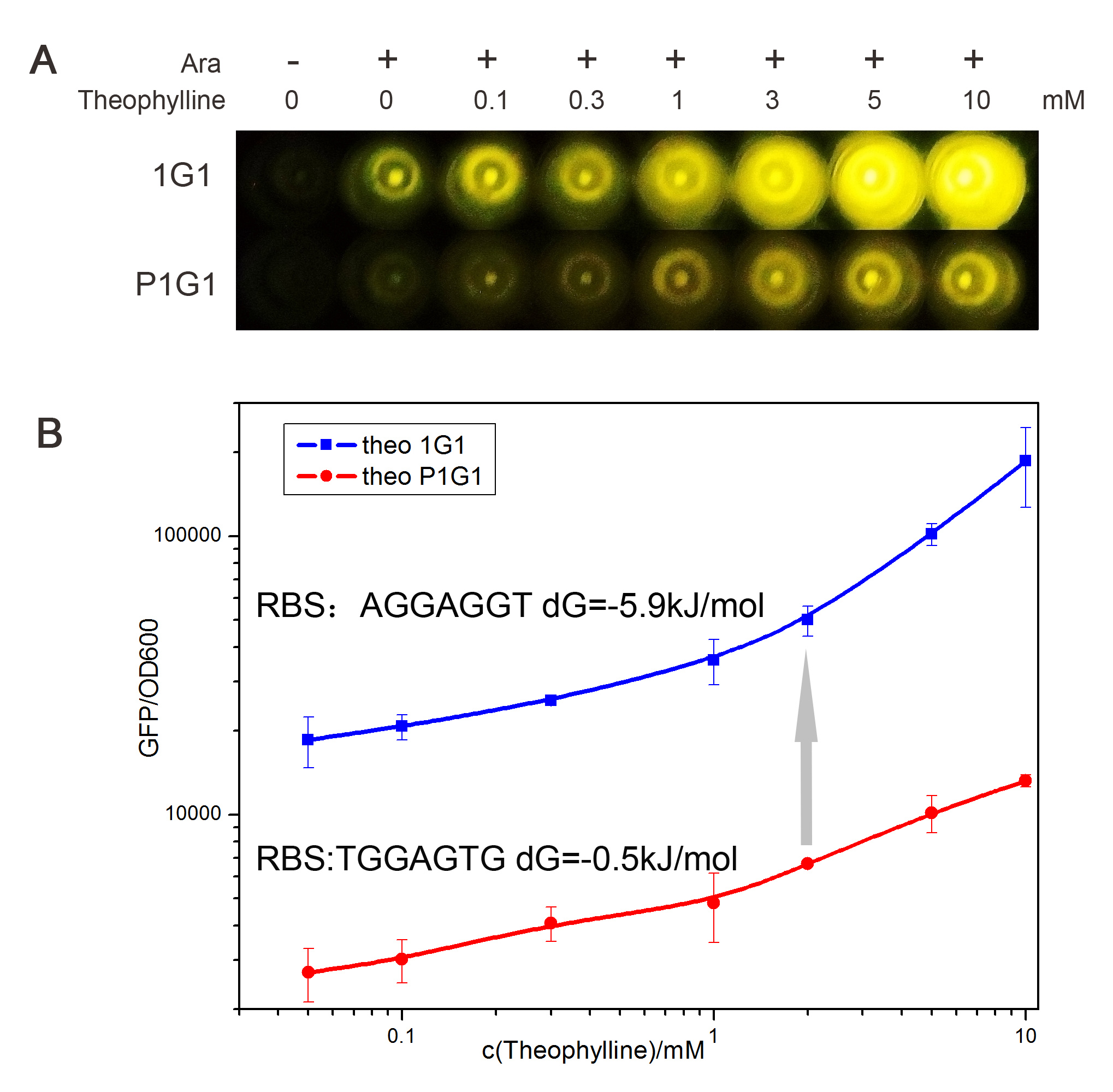
Engineered Theophylline riboswitch—Theo 1G1
Therefore, we optimized original RBS sequence of P1G1 to AGGAGGU, the consensus RBS sequence predicted to initiate high rate of translation according to the [http://2011.igem.org/Team:Peking_R/Project/RBSAutomatedDesign RBS calculator]. Simultaneously, as we positioned RNA controller 1G1 upstream of GFP coding sequence by standard assembly, the spacing between RBS and AUG strat codon is ACUAG (scar generated during standard assembly). The modification of RBS sequence and spacing between RBS and AUG start codon had inappreciable influence on the core secondary stem-loop structure of functional original riboswitch P1G1 and almost preserves the quondam base-pairing region. Stem-loop structure of 1G1 is schematized in Fig.6. 1G1 shares the same slipping mechanism with P1G1.
Dose response curve is shown in Fig.5. 1G1 displays a 10-fold activation ratio of the absence to presence of 10mM theophylline (Fig.5). However, under a concentration of 5mM theophylline, 1G1 shares similar activation ratio with P1G1, consistent with the prediction that alteration of RBS provides more flexible absolute translation strength with a fixed regulative range. Inspection of these two version of theophylline riboswitch reveals that 1G1 with the highest level of expression in the presence of theophylline not only possesses a longer RBS sequence (AGGAGGU) than P1G1, but also a more optimal spacing (5nt upstream to AUG start codon). Comparison of basal level of P1G1 and 1G1 suggests that 1G1 holds a more significant leakage in the absence of theophylline than P1G1, coincident with the holistic high expression of 1G1. According to our experiment data, engineered riboswitch possesses a more optimal absolute translation rate range, consistent with the prediction that a stronger RBS provides the RNA controller with a stronger regulation capability.
Further Application
Screening for well performing devices usually requires laborious, time-consuming refinement cycles, especially in the case of information processing devices. Utilizing the platform introduced this year ([http://2011.igem.org/Team:Peking_R/Project Peking_R, iGEM2011]), we aim at making tuning devices fast, affordable and more predictable. To demonstrate the versatility and validity of the platform, it was firstly applied to modulating a genetic AND gate.
The AND gate we utilized was designed by Anderson and his colleagues and consequently standardly redesigned by PKU_Beijing 09 team (BBa_K228258, Fig. 7A).
Here are some of the results, for detailed description, please have a look at [http://2011.igem.org/Team:Peking_R/Project our soft-coding platform].
Minor differences in RBS strength may largely influence the performance of genetic program, consistent with the fact that tuning genetic circuits requires laborious and refinement cycles, especially in the case of complex systems. When applying our platform into optimizing genetic circuts, the soft-coding of genetic program, with riboswitches' assistance, makes synthetic biology fast, affordable and more predictable.
In summary, our semi-rational method to modify RNA controller (in our case, theophylline riboswitch) offers a promising clue for optimizing the performance of RBS-related riboswitches. The application of riboswitch provides solid evidence that it contains various functional potential which would be further exploited.
References
[1]Nahvi,A., Sudarsan,N., Ebert,M.S., Zou,X., Brown,K.L. and Breaker ,R.R. (2002) Genetic control by a metabolite binding mRNA. Chem. Biol., 9, 1043-1049.
[2]Beatrix Suess, Barbara Fink, Christian Berens, Régis Stentz and Wolfgang Hillen. (2004) A theophylline responsive riboswitch based on helix slipping controls gene expression in vivo. Nucleic Acids Research, 32, 1610-1614.
[3]Sean A. Lynch, Shawn K. Desai, Hari Krishna Sajja, and Justin P. Gallivan. (2006) A High-Throughput Screen for Synthetic Riboswitches Reveals Mechanistic Insights into Their Function. Chem. Biol., 14, 173-184.
Related Parts
BBa_K228258 AND gate of iGEM 09 PKU_Beijing
BBa_K598005 Theophylline Responsive Riboswitch P1G1 with Native RBS
BBa_K598006 Theophylline Responsive Riboswitch 1G1 with Engineered RBS
BBa_K598007 Theophylline Responsive Riboswitch P1G1 with Native RBS+E0040+B0015
BBa_K598009 pBAD+Theophylline Responsive Riboswitch P1G1 with Native RBS+E0040+B0015
BBa_K598010 pBAD+Theophylline Responsive Riboswitch 1G1 with Engineered RBS+E0040+B0015
BBa_K598027 AND gate (BBa_K228258) regulated by theophylline riboswitch P1G1 (BBa_K598005)
//function/reporter/fluorescence
//regulation/positive
//rna/riboswitch
regulator
| chassis | E. coli DH5α |
| emit | 511 nm |
| excite | 501 nm |
| ligands | theophylline |
| n/a | Theophylline Responsive Riboswitch 1G1 with Engineered RBS+GFP generator |
| output | GFP |
| rbs | robust |
| resistance | Chloramphenicol |

